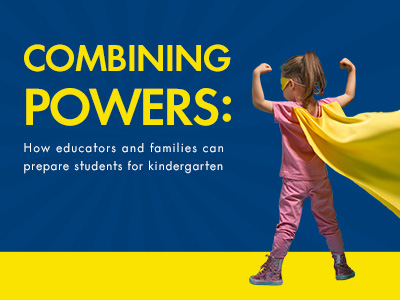What a year this has been.
If you’re a teacher, parent, or caretaker to a Pre-K child, you might be worried about what this school year means for children’s kindergarten readiness. But you can take comfort in this one, simple fact: for young children, learning = play. It’s really as simple as that.
To help you enable learning that is joyful and active, we've put together a list of 5 child-friendly ways teachers and parents can team up to support children as they prepare for kindergarten.
- Let's Play!
One of the best activities for social-emotional development is so simple, you'll have a hard time getting children to stop doing it. It's play!
In Pre-K, dramatic play can be a social experience where children agree on a play topic and mutually develop rules. In fact, involvement in dramatic play is associated with higher literacy abilities, self-regulation, oral language skills, and later school achievement.
So with this in mind, why not play school? Children, especially at this age, love to play school. Take turns being the student or the teacher with your child, and who knows, you may learn something new!
- Meal Prep
Pre-K children are developing rapidly, and though they have more coordination than they did at ages 2 or 3, they need opportunities to build both fine and gross motor skills and expand their palettes.
Getting little ones to prep meals with us is another wonderful way to boost these skills, and hey, we can all use some help in the kitchen right about now!
- Draw A Person
One indicator for school readiness is a child's ability to draw, specifically their ability to draw a person. Often times, a child will first start to draw a person around 3 or 4 years of age.
We have an entertaining activity to share that not only helps young learners develop strong drawing and cognitive skills, but also builds sequencing, counting, and language skills.
Meet Mat Man®!
In a school setting, we recommend that you build Mat Man using Wood Pieces, a blue foam mat, hands cut-outs, and maybe throw in some bottle caps or buttons for the eyes and nose.However, at home, the opportunities are endless! We've seen lots of creatively built Mat People through the years, and we're certain yours will be just as unique.
To get you started here's a download of Mat Man and the lyrics to the Mat Man song, so you can sing along while you build.
- Walk and Talk
Even while social distancing, there are still plenty of opportunities to practice and boost children's language skills. In fact, they may be picking up even more than you realize because children build receptive vocabulary before building expressive vocabulary.
That's just a fancy way of saying that they can understand what you're saying before they can use the words themselves. One of the early stages of literacy is phonological awareness, or the ability to understand and see connections between similar words.
The next time you take a walk outside, have your children look for things that start with the /s/ sound. Sky, sun, stop sign, sidewalk...and there you go, you're working on an important skill and getting your daily steps in!
- Get in Shape with Shapes
This game is called Simon Says Shapes, and it's designed to help children think about the names and properties of shapes.
Here's how you play: Scatter a bunch of shapes on the floor. If you don't have pre-made shapes at home you can make them out of construction paper, felt, or foam. Remember: start easy and use very familiar shapes like rectangles, squares, circles, and triangles. The object of the game is for children to listen to Simon's directions to locate the right shapes.
As Simon, you can ask them to: - Jump to a triangle.
- Put your hand on a square.
- Stomp on a circle.
Once they know more about the characteristics of shapes, you can add: - Simon says, sit on a shape with three sides.
- Now jump to a shape with four corners.
Oops, Simon didn't say...
See how fun being active with shapes can be?!
Keep learning by watching our free on-demand webinar.
 We have shared 5 ways educators and families can prepare children for kindergarten while distance learning. If you’re ready to learn more, check out our free on-demand webinar here where we take a deeper dive and discover virtual and hands-on strategies for preparing Pre-K students for kindergarten. Watch Webinar →
We have shared 5 ways educators and families can prepare children for kindergarten while distance learning. If you’re ready to learn more, check out our free on-demand webinar here where we take a deeper dive and discover virtual and hands-on strategies for preparing Pre-K students for kindergarten. Watch Webinar →